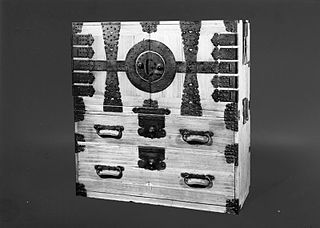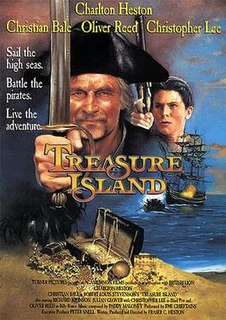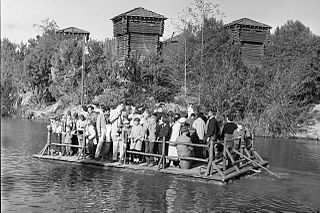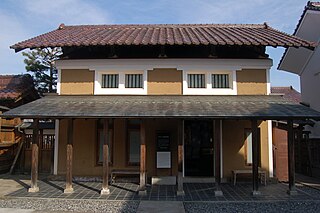

A seaman's chest is a wooden chest which was commonly used by sailors to store personal belongings. They are also known as sea chests, not to be confused with the recesses found in the hull of certain ships.
Contents



A seaman's chest is a wooden chest which was commonly used by sailors to store personal belongings. They are also known as sea chests, not to be confused with the recesses found in the hull of certain ships.

Seaman's chests were stored in the crew's quarters and were used as seats as well as containers for sailors' personal effects. Items that were stored in these chests include clothing, tools, keepsakes, and things for entertainment, such as books or cards. [1] Most seaman's chests were decorated only with a coat of paint and the owner's name, although some had intricate paintings or carvings. [2] Chests are mounted on two parallel wooden beams, similar to runners, which helps to prevent damage from sliding as well as insulating them from moisture on the floor of the ship. The sides of the chests are not vertical, but rather slant inwards slightly. This lowers the center of gravity, making the chests less likely to tip over. The lid of a seaman's chest extends over the sides and is intended to be used as a seat. Seaman's chests are always equipped with a lock as well as handles on either side, known as beckets. These handles were made of cordage and were often woven into decorative patterns by sailors. Almost all chests contained at least one small compartment attached to the right-hand side, though some had compartments extending across the entire length of the interior.
This novel contains a description of the contents of a seaman's chest belonging to pirate Barry Bones.
A strong smell of tobacco and tar rose from the interior, but nothing was to be seen on the top except a suit of very good clothes, carefully brushed and folded. They had never been worn, my mother said. Under that, the miscellany began—a quadrant, a tin canikin, several sticks of tobacco, two brace of very handsome pistols, a piece of bar silver, an old Spanish watch and some other trinkets of little value and mostly of foreign make, a pair of compasses mounted with brass, and five or six curious West Indian shells.
Though these belongings would have been reasonable for a former first mate and pirate such as Bones, most sailors would have only owned a few essential possessions, namely clothes and bedding. [3]

Treasure Island is an adventure novel by Scottish author Robert Louis Stevenson, telling a story of "buccaneers and buried gold". It is considered a coming-of-age story and is noted for its atmosphere, characters, and action.
Captain Samuel Bellamy, later known as "Black Sam" Bellamy, was an English sailor, turned pirate, who operated in the early 18th century. He is best known as the wealthiest pirate in recorded history, and one of the faces of the Golden Age of Piracy. Though his known career as a pirate captain lasted little more than a year, he and his crew captured at least 53 ships. Called "Black Sam" in Cape Cod folklore because he eschewed the fashionable powdered wig in favor of tying back his long black hair with a simple band, Bellamy became known for his mercy and generosity toward those he captured on his raids. This reputation earned him another nickname, the "Prince of Pirates". He likened himself to Robin Hood, with his crew calling themselves "Robin Hood's Men".

A trunk, also known as a travel trunk, is a large cuboid container designed to hold clothes and other personal belongings. They are most commonly used for extended periods away from home, such as for boarding school, or long trips abroad. Trunks are differentiated from chests by their more rugged construction due to their intended use as luggage, instead of the latter's pure storage.
This is a glossary of nautical terms; some remain current, while many date from the 17th to 19th centuries.

A chest is a form of furniture typically of a rectangular structure with four walls and a removable or hinged lid, used for storage, usually of personal items. The interior space may be subdivided.
"Dead Man's Chest" is a fictional sea song, originally from Robert Louis Stevenson's novel Treasure Island (1883). It was expanded in a poem, titled "Derelict" by Young E. Allison, published in the Louisville Courier-Journal in 1891. It has since been used in many later works of art in various forms.

"Shiver me timbers" is an exclamation in the form of a mock oath usually attributed to the speech of pirates in works of fiction. It is employed as a literary device by authors to express shock, surprise, or annoyance. The phrase is based on real nautical slang and is a reference to the timbers, which are the wooden support frames of a sailing ship. In heavy seas, ships would be lifted up and pounded down so hard as to "shiver" the timbers, startling the sailors. Such an exclamation was meant to convey a feeling of fear and awe, similar to, "Well, blow me down!", or, "May God strike me alive and well". Since on the high seas the ship was the sailors' 'world', it may also be interpreted as an exclamation for "shake my world" as the subject being referred to could be, or may be considered a potentially 'world shaking' event. "Shiver" is also reminiscent of the splintering of a ship's timbers in battle – splinter wounds were a common form of battle injury on wooden ships. Can also be used as an expression of being "cold to the bone".

The Black Spot is a literary device invented by Robert Louis Stevenson for his novel Treasure Island. In the book, pirates are presented with a "black spot" to officially pronounce a verdict of guilt or judgement. It consists of a circular piece of paper or card, with one side blackened while the other side bears a message and is placed in the hand of the accused. It was a source of much fear because it meant the pirate was to be deposed as leader, by force if necessary—or else killed outright. In Treasure Island, Billy Bones is much frightened by it, yet remains determined to outwit his enemies; however, he suffers a stroke caused by the overconsumption of liquor and is killed by the blind beggar. Later Long John Silver receives the spot, but is calm enough to notice that the paper bearing the spot has been torn out from a Bible, and warns his associates of the bad luck this will bring upon them.

Nelson's Dockyard is a cultural heritage site and marina in English Harbour, located in Saint Paul Parish on the island of Antigua, in Antigua and Barbuda.

Tansu are traditional Japanese mobile storage cabinets. Tansu are commonly used for the storage of clothing, particularly kimono.

Treasure Island is a 1934 film directed by Victor Fleming and starring Wallace Beery, Jackie Cooper, Lionel Barrymore, Lewis Stone, and Nigel Bruce. It is an adaptation of Robert Louis Stevenson's famous 1883 novel of the same name. Jim Hawkins discovers a treasure map and travels on a sailing ship to a remote island, but pirates led by Long John Silver threaten to take away the honest seafarers’ riches and lives.

Treasure Island is a 1990 British-American made-for-television film adaptation of Robert Louis Stevenson’s 1883 novel of the same name, written and directed by Fraser Clarke Heston, and also starring several notable British actors, including Christian Bale, Oliver Reed, Christopher Lee, Julian Glover and Pete Postlethwaite.

Tom Sawyer Island is an artificial island surrounded by the Rivers of America at Disneyland, Magic Kingdom and Tokyo Disneyland. It contains structures and caves with references to Mark Twain characters from the novel The Adventures of Tom Sawyer, and provides interactive, climbing, and scenic opportunities. At Disneyland in 2007, the attraction was rethemed and expanded as Pirate's Lair on Tom Sawyer Island, adding references to Disney's Pirates of the Caribbean film series.

Billy Bones is a fictional character appearing in the first section of Robert Louis Stevenson's 1883 novel Treasure Island.
Dr. David Livesey is a fictional character in the 1883 novel Treasure Island by Robert Louis Stevenson. As well as doctor, he is a magistrate, an important man in the rural society of southwest England, where the story opens; his social position is marked by his always wearing a white wig—even in the harsh conditions of the island on which the adventure takes place.

Felipe González de Ahedo, also spelled Phelipe González y Haedo, was a Spanish navigator and cartographer known for annexing Easter Island in 1770.

Kura are traditional Japanese storehouses. They are commonly durable buildings built from timber, stone or clay used to safely store valuable commodities.
LST-172 was an American World War II Landing Ship, Tank.
This is a list of nautical terms starting with the letters M to Z.